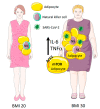COVID-19 and Obesity: Dangerous Liaisons
- PMID: 32759719
- PMCID: PMC7465218
- DOI: 10.3390/jcm9082511
COVID-19 and Obesity: Dangerous Liaisons
Abstract
Besides advanced age and the presence of multiple comorbidities as major contributors to increased risk of severe disease and fatal outcome from Severe Acute Respiratory Syndrome coronavirus 2 (SARS-CoV-2) disease (COVID-19), there is now emerging evidence that overweight and obesity predispose to severe symptoms and negative prognosis. Remarkably, the severity of COVID-19 appears to rise with increasing body mass index (BMI). The association between COVID-19 outcomes and overweight/obesity has biological and physiological plausibility. Potential pathophysiological mechanisms that may explain this strong association include the chronic pro-inflammatory state, the excessive oxidative stress response, and the impaired immunity that is commonly reported in these individuals. The role of cytokines, mammalian target of rapamycin (mTOR), and altered natural killer cell polarization in the dangerous liaison between COVID-19 and obesity are discussed here. These pathways can favor and accelerate the deleterious downstream cellular effects of SARS-CoV-2. Moreover, obesity is well known to be associated with reduced lung function and poor response to mechanical ventilation, thus placing these individuals at high risk of severe illness and mortality from COVID-19. Furthermore, obesity may lead to other complications, such as renal failure, cardiovascular dysfunction, hypertension, and vascular damage, which in turn can further accelerate negative clinical outcomes from COVID-19. Obese individuals should be shielded against any potential viral exposure to SARS-CoV-2 with consequential considerations for compulsory protection devices and social distancing. Health care providers should be aware that obesity predisposes to severe symptoms and negative prognosis in COVID-19 patients.
Keywords: ACE2; COVID-19; IL-6 pathway; SARS-CoV-2; adipokines; cytokine storm; obesity; renin–angiotensin system (RAS) pathway.
Conflict of interest statement
R.P. is full-time employee at the University of Catania, Italy. In relation to the topic of communicable disease and obesity, RP has received research funding from Alfa-Wassermann, manufacturer of broad-spectrum antibiotics. R.P. is also the founder of the Center of Excellence for the acceleration of Harm Reduction at the University of Catania (CoEHAR), which has received a grant from Foundation for a Smoke-Free World to develop and carry out 8 research projects on harm reduction. R.P. is also acting as pro bono scientific advisor for LIAF, Lega Italiana Anti Fumo (Italian acronym for Italian Anti-Smoking League). All other authors declare no conflict of interest.
Figures

References
-
- Wuhan Municipal Health Commission Report of Clustering Pneumonia of Unknown Etiology in Wuhan City. [(accessed on 31 May 2020)];2019 Available online: Wjw.wuhan.gov.cn/front/web/showDetail/2019123108989.
-
- Zhou F., Yu T., Du R., Fan G., Liu Y., Liu Z., Xiang J., Wang Y., Song B., Gu X., et al. Clinical course and risk factors for mortality of adult inpatients with COVID-19 in Wuhan, China: A retrospective cohort study. Lancet. 2020;395:1054–1062. doi: 10.1016/S0140-6736(20)30566-3. - DOI - PMC - PubMed
Publication types
LinkOut - more resources
Full Text Sources
Miscellaneous

